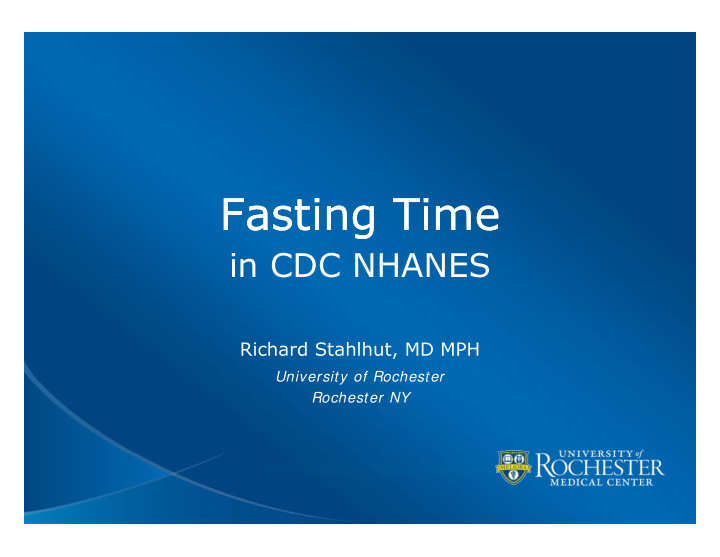



Fasting Fasting T Time ime in CDC NHANES Richard Stahlhut, MD MPH University of Rochester y Rochester NY
I n Sum m ary … y Fasting time can affect results of NHANES (and other epi) studies, however, these effects seem less than one might expect. This reduced effect of fasting time (i.e., reduced relationship with experimental PK) could be caused by: 1) changes in absorption due to mixing with food, 2) “kinetic buffering” by body fat (mesenteric ?) during chronic exposure, 3) imprecision of fasting time as measure of time since exposure, 4) non-food routes of exposure, 5) inaccuracy of self-reported fasting. I do not know any way to conclusively validate self-reported fasting times in NHANES or other epi studies, however, my attempts to validate through use of other internal data suggests that most (not all !) fasting times are likely correct, or gg ( ) g y , correct enough . Adjusting for fasting time may give increased precision in some epi studies of rapidly-cleared, food-borne environmental toxicants, however, fasting time is linked rapidly cleared, food borne environmental toxicants, however, fasting time is linked to other covariates, and so (as always), one must think, and not simply adjust. 2
W hy do w e care about Fasting Tim e ? y g Affects on exposure measurement • Food-based exposures with rapid clearance Food based exposures with rapid clearance Affects on outcome measurement • Glucose, insulin, triglycerides, LDL, etc. , , g y , , 3
W hat is “Fasting Tim e” ( FT) in NHANES ? W hat is Fasting Tim e ( FT) in NHANES ? FT = hours/minutes since last food or drink “other than plain water”. • Does not consider diet drinks alcohol and minor items because • Does not consider diet drinks, alcohol, and minor items, because, presumably, the purpose of FT in NHANES is to enable valid “fasting” blood tests (fasting glucose, insulin, triglycerides, LDL). Other details: Oth d t il • Everyone has a “fasting time”, but … • “Fasting” is only considered valid if FT is between 8 and 24 hours. In 2003 4 is only from the morning session subjects ages ≥ 12 yrs etc 2003-4 is only from the morning session subjects, ages ≥ 12 yrs, etc.. • Fasting data is invalidated by zeroing out subsample WEIGHTS, not the data itself. For our purposes, this is good. WARNING: these details can CHANGE 4
5
6
Factors affecting FT g • Session (morning, afternoon evening) afternoon, evening) • Age • Insulin status (2003-4) • Insulin status (2003 4) 7
Factors affecting FT g • Session (morning, afternoon evening) afternoon, evening) • Age • I nsulin status ( 2 0 0 3 -4 ) • I nsulin status ( 2 0 0 3 4 ) 8
9 FT affecting … g BPA
MEHHP (ln, creat-corrected) MEP (ln, creat-corrected) 10
MEHHP (more specific urine creat subset, 2005-6) 11
n) tinine (ln rine Crea Ur Increasing concentration (+ / - mild catabolism ?) 12
Yes, but can w e trust self-reported , p Fasting Tim es ??? Especially given: p y g • Unexpected BPA and MEHHP results ? • Additional payment (+~$30) if properly fasting ? 13
14 Validation attem pts/ clues …
15 More ideas …
% of norm oglycem ic subjects w ith “good” serum glucose (i.e., did not eat recently, maybe) 16
I nsulin ( ln) – (diabetes = 1 OR on.insulin = 1) or NOT 17
18 Use dietary survey to cross-check Stronger validation ?
19
20
Sam e + fasting.tim e HOMA ( ln) = MEHHP ( ln) + covars 21
I n Sum m ary … y Fasting time can affect results of NHANES (and other epi) studies, however, these effects seem less than one might expect. This reduced effect of fasting time (i.e., reduced relationship with experimental PK) could be caused by: 1) changes in absorption due to mixing with food, 2) “kinetic buffering” by body fat (mesenteric ?) during chronic exposure, 3) imprecision of fasting time as measure of time since exposure, 4) non-food routes of exposure, 5) inaccuracy of self-reported fasting. I do not know any way to conclusively validate self-reported fasting times in NHANES or other epi studies, however, my attempts to validate through use of other internal data suggests that most (not all !) fasting times are likely correct, or gg ( ) g y , correct enough . Adjusting for fasting time may give increased precision in some epi studies of rapidly-cleared, food-borne environmental toxicants, however, fasting time is linked rapidly cleared, food borne environmental toxicants, however, fasting time is linked to other covariates, and so (as always), one must think, and not simply adjust. 22
Recommend
More recommend